Overview
Developers often encounter significant challenges in maintaining their codebases, which can hinder productivity and innovation. Kodezi OS emerges as a solution to these coding challenges, offering features that automate essential tasks. For instance, it efficiently handles bug detection, documentation syncing, and compliance enforcement. By automating these routine tasks, Kodezi OS allows development teams to focus on what truly matters: innovation.
Imagine the time saved when bug detection is automated, freeing developers to concentrate on creating new features rather than troubleshooting. Furthermore, Kodezi's ability to sync documentation ensures that all team members are on the same page, which is crucial for maintaining code quality. In addition, compliance enforcement is streamlined, reducing the risk of costly errors.
The benefits of using Kodezi OS are clear: enhanced productivity and improved code quality. By shifting the focus from maintenance to innovation, teams can achieve greater efficiency in their software development processes. Why not explore the tools available on the Kodezi platform and see how they can transform your coding practices?
In summary, Kodezi OS not only addresses common pain points faced by developers but also empowers them to elevate their work. With its automation capabilities and focus on innovation, Kodezi is an invaluable asset for any development team.
Introduction
In the ever-evolving landscape of software development, developers face numerous challenges in maintaining a clean and efficient codebase. How can teams effectively navigate these complexities? Enter Kodezi OS, an innovative infrastructure layer designed to automate codebase maintenance. By proactively identifying and resolving issues, Kodezi OS not only conserves valuable time but also enhances overall productivity, allowing developers to focus on strategic initiatives rather than routine upkeep.
With features such as bug healing, documentation syncing, and entropy detection, Kodezi OS emerges as an indispensable ally for organizations striving to uphold high standards of code quality and security in a fast-paced digital world. Imagine a tool that takes care of the mundane aspects of coding, enabling your team to concentrate on what truly matters. As development practices continue to evolve, tools like Kodezi OS are set to redefine how teams approach software maintenance, ensuring they remain agile and competitive.
Are you ready to explore how Kodezi OS can transform your coding practices? Discover the tools available on the platform and elevate your development process today.
Kodezi OS: Automate Codebase Maintenance for Enhanced Efficiency
In today's fast-paced development landscape, maintaining a clean and efficient codebase is a significant challenge for many engineering teams. Kodezi OS serves as an independent infrastructure layer that directly addresses these complexities. By continuously monitoring codebases, it autonomously identifies and resolves issues, ensuring that your code remains clean, compliant, and production-ready.
Imagine saving valuable time while enhancing overall efficiency—this is precisely what Kodezi offers. With 72% of organizations unifying security and observability, the demand for automated solutions is more pressing than ever. Kodezi’s proactive maintenance strategy allows teams to focus on strategic initiatives rather than being bogged down by routine upkeep.
Furthermore, consistent refactoring, as specialists recommend, can prevent codebase expansion and intricacy. This highlights the importance of Kodezi OS use cases in sustaining high-performance software development environments. Why not explore the tools available on the Kodezi platform to elevate your coding practices?
With Kodezi, you can transform your approach to codebase management, ensuring that your team's productivity and code quality reach new heights.

Kodezi OS Bug Healing: Automatically Detect and Fix Code Issues
Coding challenges can be daunting for developers, particularly when it comes to bug resolution. The operating system excels in this area by automatically identifying and correcting programming issues as they occur. Utilizing advanced algorithms, it detects bugs in real-time and applies intelligent fixes without the need for manual intervention. This optimization of the debugging process significantly reduces the risk of bugs reaching production, thereby enhancing the reliability of software applications as demonstrated in kodezi os use cases.
Furthermore, this operating system addresses performance bottlenecks and identifies security issues, ensuring that the codebase adheres to the latest security best practices and coding standards. By taking a comprehensive approach, it not only optimizes performance but also enhances kodezi os use cases. As a result, developers can experience improved productivity and confidence in their code.
In addition, consider how much time you could save by utilizing these features. Imagine a development environment where bugs are resolved automatically, allowing you to focus on innovation rather than troubleshooting. This operating system stands out as an invaluable tool for developers, making it essential to explore the tools available on the platform.
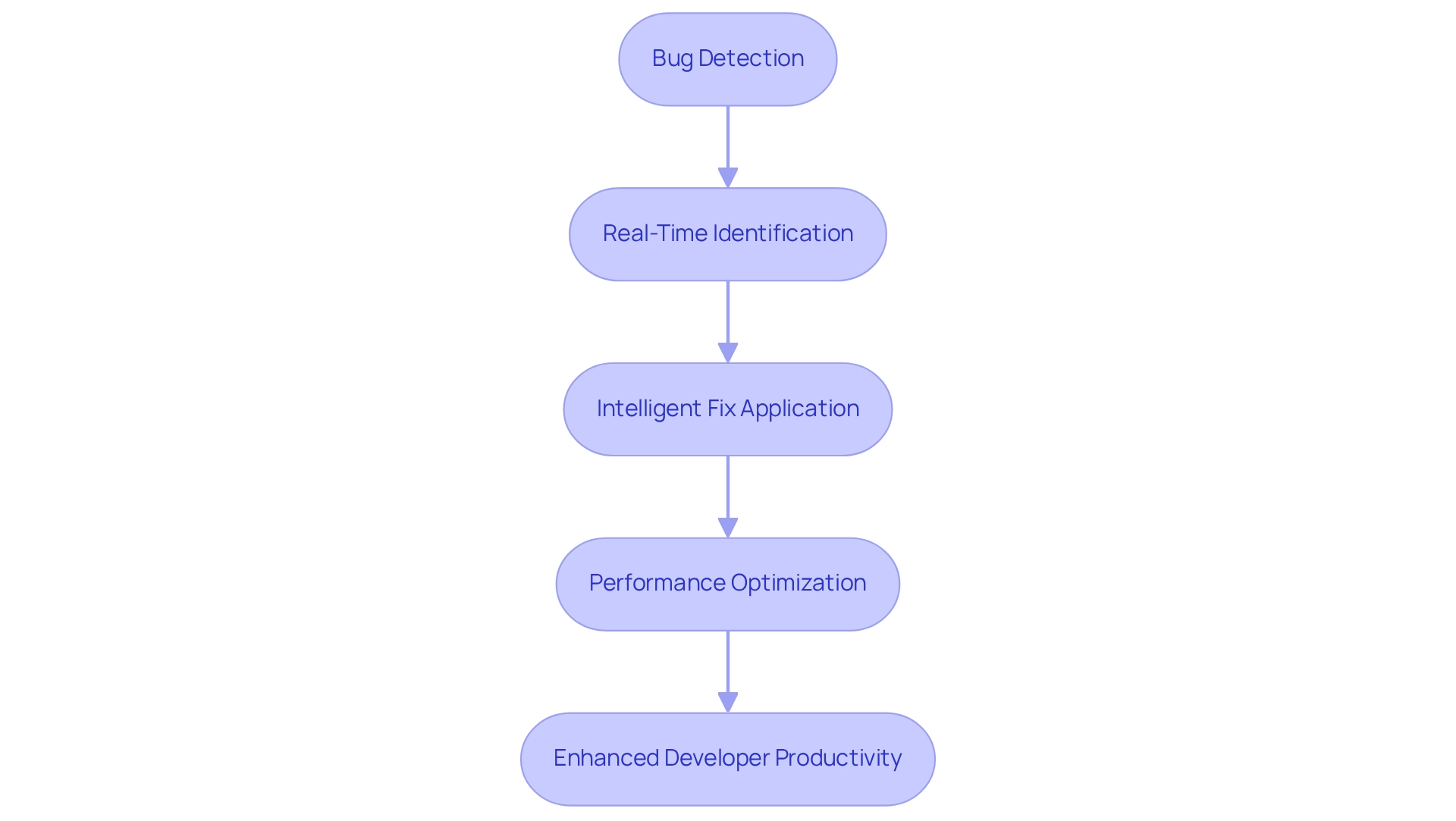
Kodezi OS Test Healing: Rewrite Flaky Tests for Consistent Performance
Flaky tests present significant challenges for developers, undermining trust in testing processes and leading to inefficiencies. How can teams overcome these hurdles? Kodezi effectively addresses this issue with its advanced test healing features, which autonomously rewrite unreliable tests to ensure consistent performance. By meticulously analyzing test results and identifying failure patterns, Kodezi suggests targeted adjustments that enhance test reliability. This proactive approach not only reduces the risks associated with unreliable tests but also empowers teams to uphold high-quality standards throughout their software development process, highlighting the importance of Kodezi's use cases in maintaining codebase integrity and team productivity.
Imagine having AI-driven automated builds and testing that enhance code quality by identifying and resolving issues before each push. This ensures that performance bottlenecks, security vulnerabilities, and coding standard violations are addressed promptly. Furthermore, Kodezi guarantees compliance with the latest security best practices and coding standards, establishing itself as a crucial ally for engineering teams striving for excellence.
Are you ready to elevate your coding practices? Explore the tools available on Kodezi's platform and experience the benefits of improved productivity and code quality.

Kodezi OS Documentation Sync: Keep Your Project Docs Updated Automatically
Effective documentation is crucial for overcoming the coding challenges developers face, particularly in promoting collaboration and facilitating knowledge transfer within project teams. The kodezi os use cases address these challenges by automatically syncing project documentation with code changes. This ensures that README files, changelogs, and inline documentation remain consistently aligned with the current state of the codebase. Furthermore, this automation conserves time, enhances security, and reduces the manual effort needed for documentation updates, allowing teams to focus more on creation rather than administrative tasks.
A well-documented system serves as a long-term asset for business growth and compliance, making documentation indispensable. In addition, automated updates to documentation foster group collaboration and help identify gaps in processes during retrospective meetings, which evaluate documented workflows and lead to improved outcomes. As technology enthusiast Avantika Shergil states, "Bridging the gap between technology and business strategy is essential for effective software development." With Kodezi, the burden of maintaining up-to-date documentation is lifted, enabling teams to concentrate on innovation and efficiency.
For instance, the tool's ability to generate OpenAPI 3.0 specifications from the codebase in seconds exemplifies how comprehensive documentation can support various formats. This capability makes it ideal for efficiently detailing product features and troubleshooting guidelines. How much time could your team save by streamlining documentation processes? Explore the tools available on Kodezi's platform to discover the kodezi os use cases that can enhance your coding practices and improve overall productivity.

Kodezi OS Entropy Detection: Identify and Manage Code Complexity
Developers often face significant challenges in managing the complexities of coding. How can they effectively navigate these issues? Kodezi OS offers sophisticated entropy detection capabilities that empower teams to recognize and address complexity in their kodezi os use cases. By analyzing the codebase for signs of entropy—such as repeated segments, overly intricate functions, and closely linked components—Kodezi OS provides valuable insights that assist in restructuring and streamlining. This proactive approach not only enhances maintainability but also significantly improves the overall quality of the software.
Furthermore, Kodezi OS features automated debugging, allowing teams to swiftly identify and resolve issues within the codebase. With detailed explanations and insights into what went wrong and how it was fixed, developers can quickly tackle performance bottlenecks, uncover security vulnerabilities, and enhance code formatting across their projects. This ensures adherence to the latest security best practices and coding standards, thereby facilitating efficient production processes.
Research indicates that a high rework ratio—defined as the total time spent correcting defects relative to the total time spent on creation—can signal inefficiencies in the software development process. Addressing these inefficiencies is crucial, as excessive time spent on fixes detracts from productive efforts. This operating system mitigates this issue by continuously monitoring code health and automating evaluations, enabling teams to focus on innovation rather than remediation.
As the landscape of software development evolves, Kodezi OS ensures that the relationship between code entropy and maintainability is effectively managed. By providing tools specifically designed to detect and resolve entropy, along with automated debugging and performance enhancement features, this operating system is ideal for kodezi os use cases as it helps maintain clean, compliant codebases that are ready for future challenges. Why not explore the tools available on the platform to elevate your coding practices?

Kodezi OS Security & Standards: Enforce Compliance and Protect Your Code
In the world of software development, safety is paramount. Developers often face significant challenges in maintaining secure codebases, especially with the increasing complexity of modern applications. This operating system excels in enforcing adherence to industry standards, autonomously scanning code for vulnerabilities and applying best practices to mitigate risks effectively.
How does it achieve this? By seamlessly incorporating security checks into the development workflow, the OS empowers teams to maintain a secure codebase, safeguarding sensitive information and ensuring compliance with regulatory requirements. In 2022, 54% of reviewed codebases included open-source components with license conflicts, underscoring the need for robust security measures. The operating system addresses this challenge through continuous monitoring and early detection of potential vulnerabilities, allowing teams to focus on innovation rather than remediation.
Furthermore, with the CLI tool, teams can uphold programming quality by identifying and resolving issues before every push. This includes tackling performance bottlenecks, pinpointing security issues, incorporating exception handling, and enhancing code formatting—all within seconds. The CLI also provides comprehensive explanations and insights into errors and their resolutions, further supporting developers in maintaining high code quality.
As companies increasingly adopt automated security compliance tools, this operating system stands out by offering a self-maintaining solution that evolves alongside the codebase. This guarantees consistent adherence to security standards, making it an invaluable resource for engineering teams navigating the complexities of modern software development. To fully leverage the advantages of this operating system, teams should regularly review the insights provided by the command line interface, proactively addressing potential vulnerabilities.
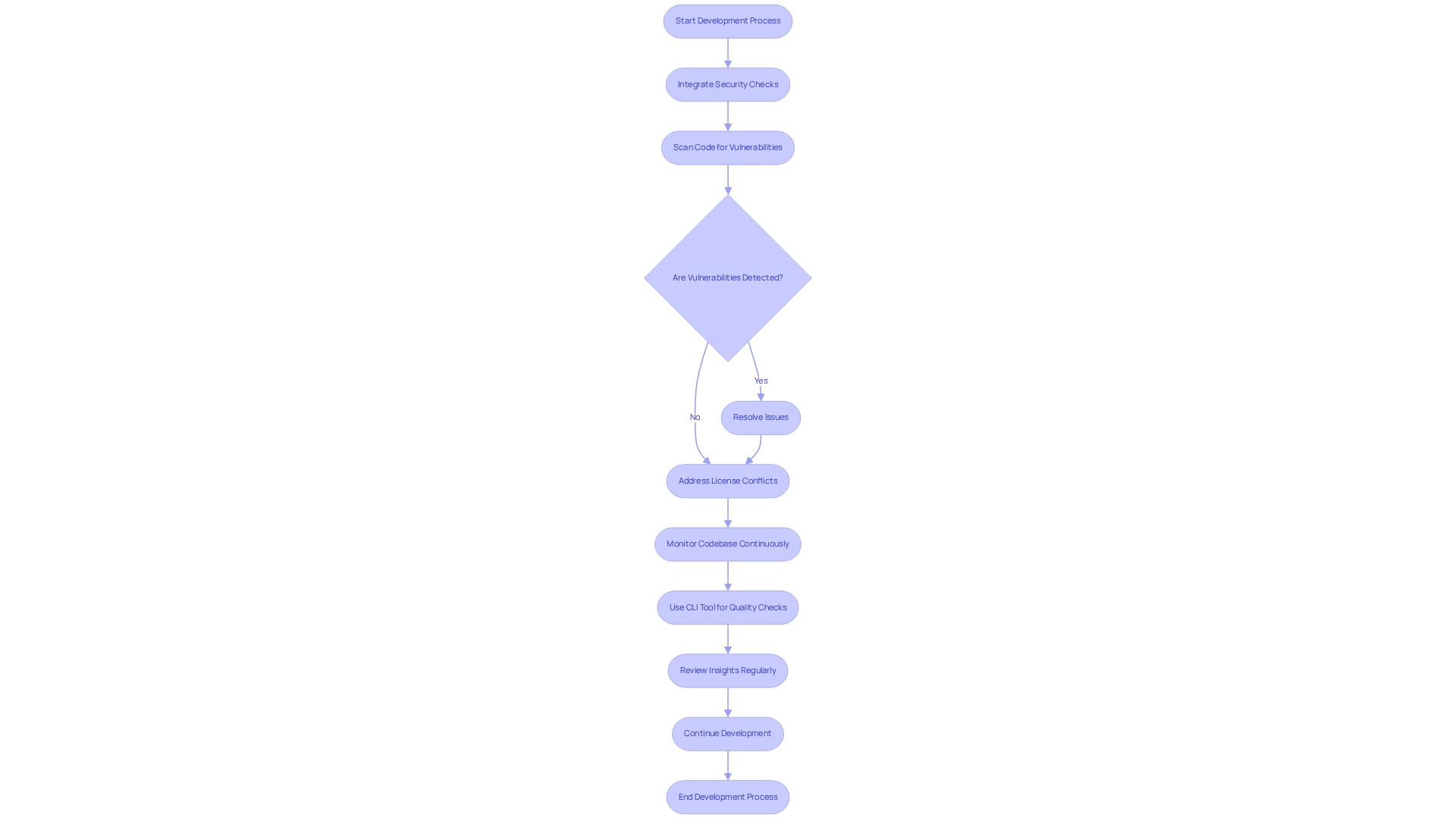
Kodezi OS Language & Framework Translation: Adapt Code Across Stacks
In today’s fast-paced development environment, coding challenges can significantly hinder productivity. How can developers effectively navigate the complexities of language and framework conversion? The Kodezi OS use cases stand out by enabling teams to adjust their programs effortlessly across diverse technology stacks. This capability is crucial for organizations using multiple programming languages or transitioning to new frameworks. By automating the translation process, the Kodezi OS use cases significantly reduce the manual effort involved in adapting scripts, enhancing development efficiency and allowing teams to leverage the most suitable tools for their projects without being constrained by language barriers.
Current best practices emphasize the importance of integrating translation tools early in the development process. This proactive approach not only streamlines workflows but also fosters collaboration among team members, leading to improved project outcomes.
Furthermore, Kodezi’s suite of developer tools automates code reviews, maintains API documentation in alignment with software changes, generates OpenAPI specifications from your project base, and hosts Swagger UI sites for testing API endpoints. By utilizing Kodezi OS use cases, organizations can stay ahead of the curve, ensuring their codebases remain clean, compliant, and ready for future advancements.
Explore the powerful tools available on the Kodezi platform and discover how they can transform your development experience.
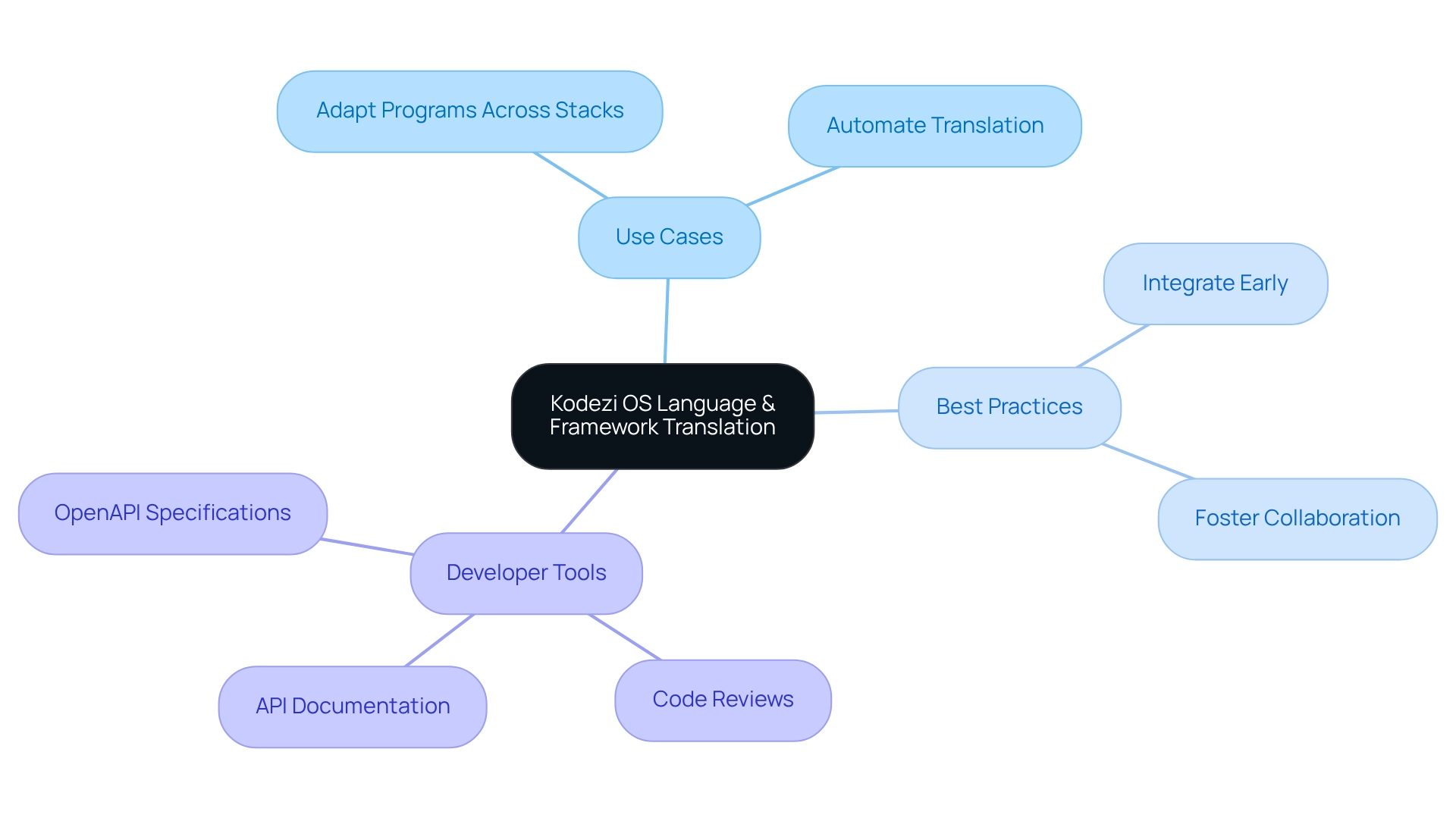
Kodezi OS Auto PR Generator: Streamline Code Fix Proposals
Developers often face significant challenges in coding, particularly when it comes to managing pull requests and ensuring code quality. The kodezi os use cases address these issues head-on with its auto PR generator feature, which transforms the process of suggesting fixes by automatically generating pull requests that include detailed descriptions of the modifications made. This automation significantly improves the review process, conserving developers' valuable time while ensuring that all necessary information is easily accessible in the PR.
Furthermore, teams benefit from more seamless collaboration and quicker approvals, which is essential in today’s fast-paced innovation environments. The AI enhances programming alterations throughout the software creation lifecycle, with automated testers identifying issues before they escalate, thus improving quality with every release.
In addition, the integration of the OS with existing workflows through the GitHub API, which offers over 500 endpoints, enables effortless monitoring of progress and revisions on pull requests. This ultimately enhances the entire review process. Organizations observing significant improvements in efficiency are utilizing kodezi os use cases for automated pull request creation tools. These tools not only reduce the manual workload but also enhance the quality of reviews, resulting in more resilient software practices.
Are you ready to explore how Kodezi can streamline your coding practices? Discover the tools available on the platform to elevate your development experience.
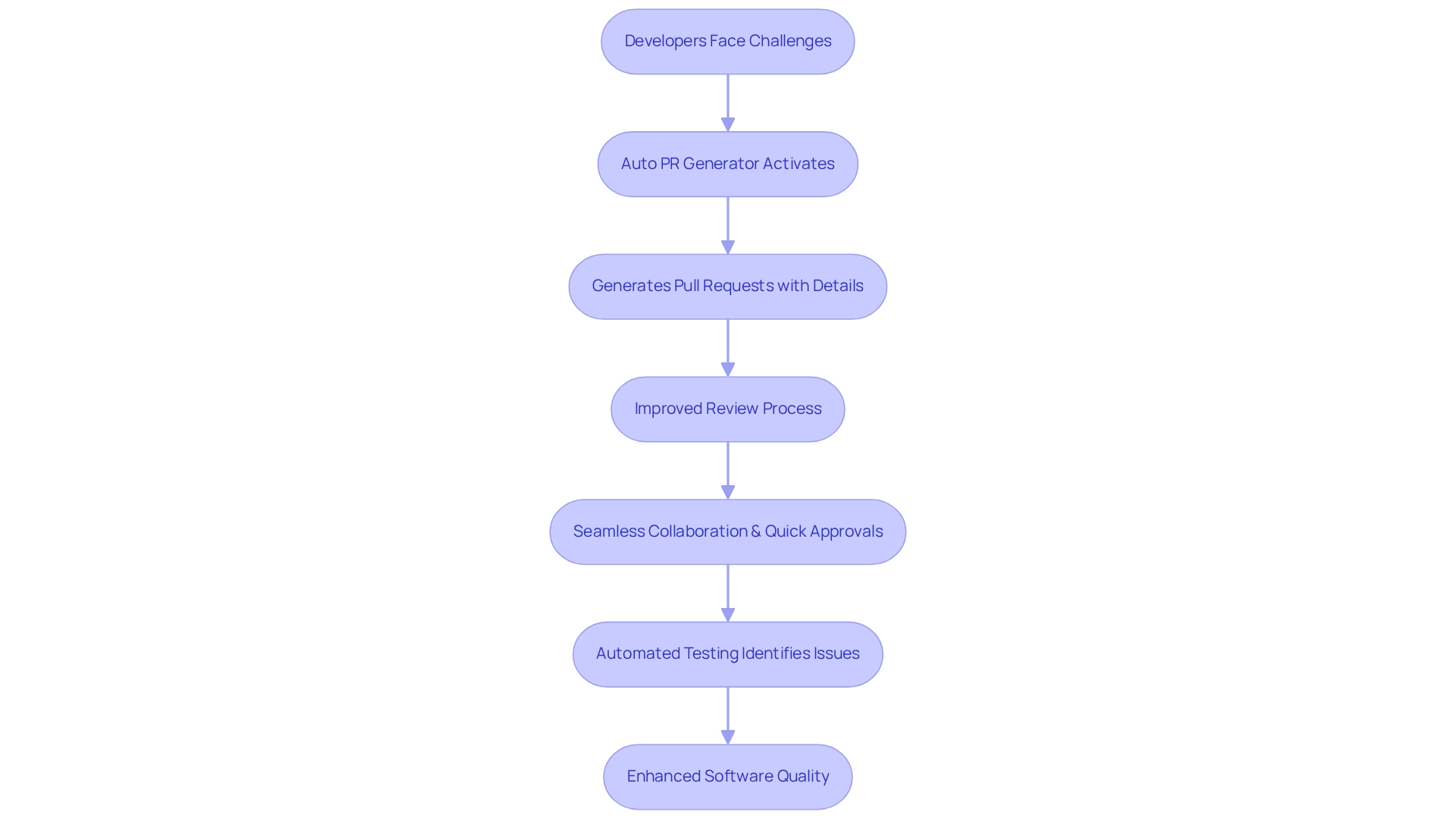
Kodezi OS Integration: Enhance Collaboration with GitHub and CI/CD
Coding challenges can often hinder developer productivity. However, the kodezi os use cases offer a solution through its seamless integration with GitHub, CI/CD pipelines, and observability platforms. This integration significantly enhances collaboration among development groups. With automated bug fixes, documentation updates, and program optimizations embedded directly within current workflows, teams can reduce disruption and operate more efficiently.
But how does this impact your workflow? By utilizing the automated code debugging feature, teams can swiftly pinpoint and address codebase issues. This ensures compliance with the latest security best practices and coding standards, ultimately fostering a more secure coding environment.
Moreover, automating routine tasks allows teams to concentrate on higher-value activities. This shift not only boosts productivity but also leads to improved outcomes in codebase maintenance. Are you ready to elevate your coding practices? Explore the kodezi os use cases available on the Kodezi platform to experience these benefits firsthand.
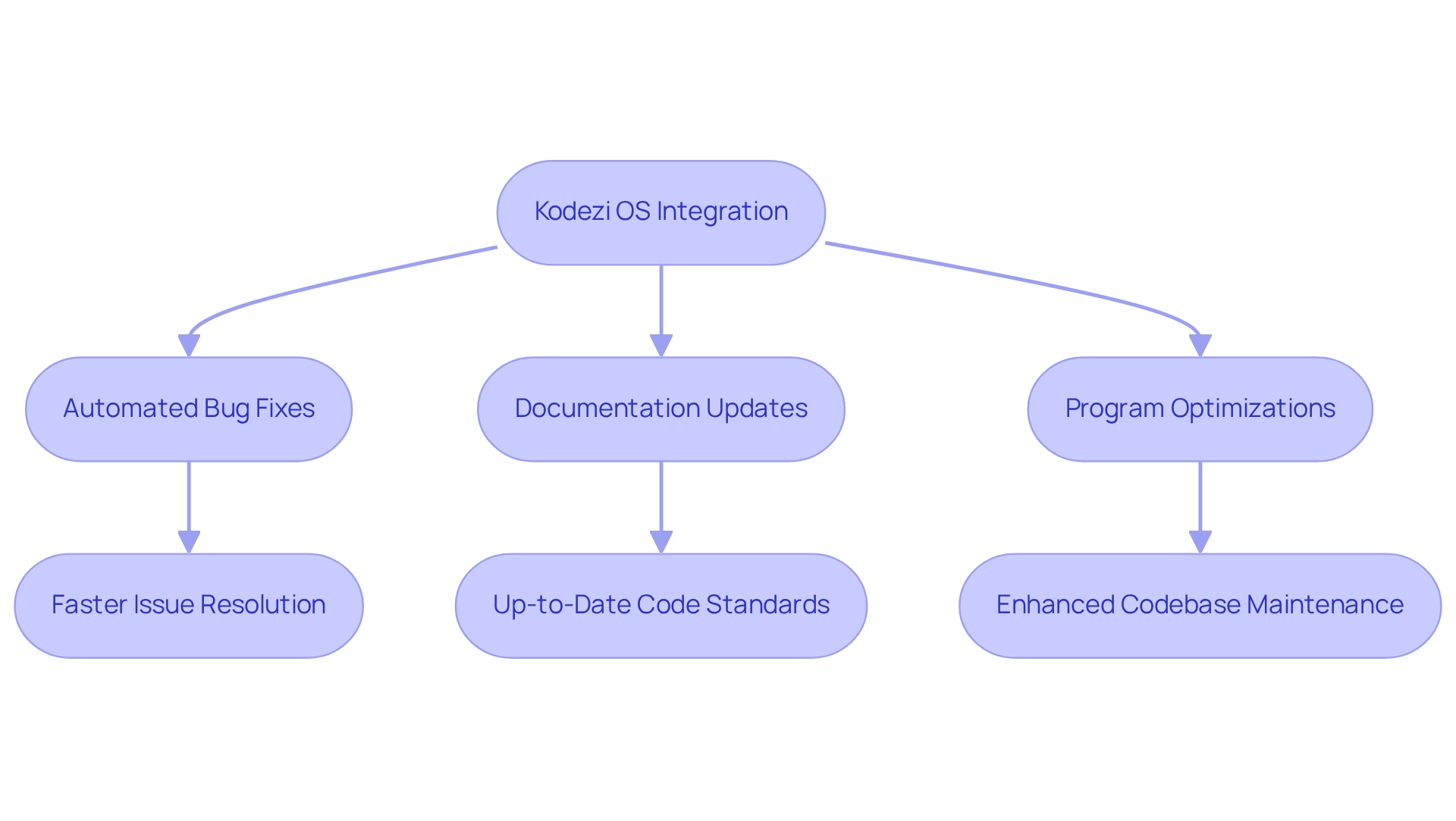
Kodezi OS Self-Healing Infrastructure: Build Long-Term Maintainability
Coding challenges can often feel overwhelming for developers. How can one ensure that code remains clean and up to industry standards? The innovative self-healing infrastructure of Kodezi OS use cases addresses these concerns by autonomously maintaining and evolving codebases over time. By consistently monitoring for issues and implementing solutions as needed, Kodezi OS ensures that programming practices are efficient and adhere to best practices in the field, as illustrated by various Kodezi OS use cases.
With features like automated code debugging, Kodezi OS can instantly identify and resolve codebase issues, fix performance bottlenecks, and enhance code formatting. This self-sustaining approach significantly reduces the burden on development teams. Furthermore, it cultivates a culture of long-term maintainability, allowing organizations to scale their software solutions effectively while keeping pace with the latest security best practices.
Imagine a development environment where code quality is consistently maintained without constant oversight. Wouldn't it be beneficial to focus on innovation rather than maintenance? By utilizing the Kodezi OS use cases, developers can experience enhanced productivity and improved code quality, leading to greater overall efficiency in their projects. Explore the tools available on the Kodezi platform and discover how they can transform your coding practices.
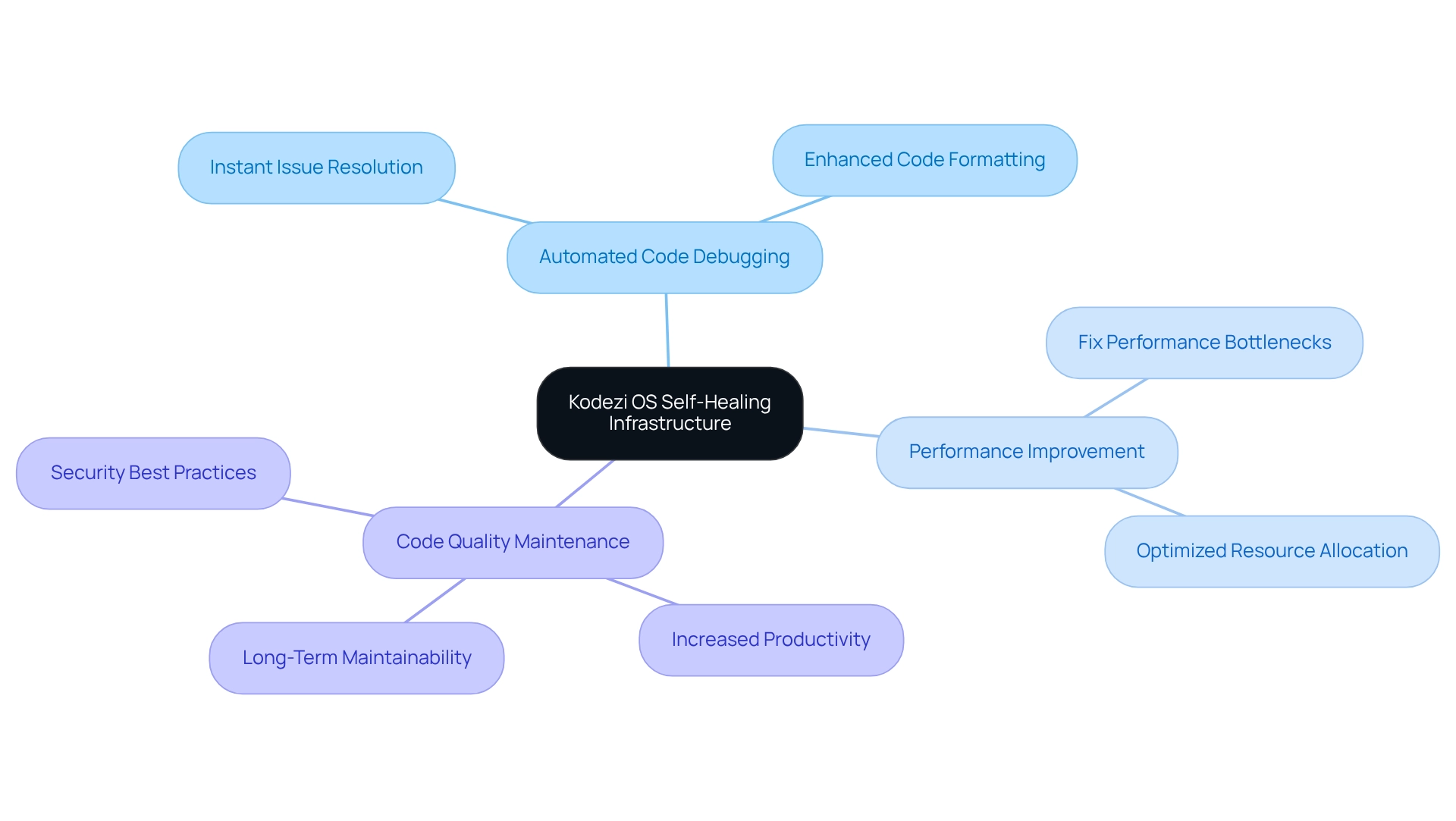
Conclusion
The challenges of modern software development can be overwhelming for developers. Kodezi OS emerges as a transformative solution, automating essential tasks like codebase maintenance, bug healing, documentation syncing, and entropy detection. This allows teams to concentrate on strategic initiatives, enhancing productivity while ensuring that code quality and security standards are consistently upheld.
As organizations navigate the complexities of software development, the proactive features of Kodezi OS become indispensable. It automatically detects and fixes issues, rewrites flaky tests, and enforces compliance with security best practices. This streamlines workflows and fosters a culture of innovation, particularly through its integration with platforms like GitHub and CI/CD, which enhances collaboration and maintains high performance and agility in development processes.
Ultimately, Kodezi OS is more than just a tool; it serves as a strategic partner in the ever-evolving landscape of software engineering. By leveraging its advanced capabilities, development teams can ensure their codebases remain clean, compliant, and ready for future challenges. Embracing Kodezi OS positions organizations for success in the fast-paced digital world while fostering an environment where creativity and efficiency thrive.
Frequently Asked Questions
What is Kodezi OS?
Kodezi OS is an independent infrastructure layer designed to automate codebase maintenance, continuously monitor codebases, and autonomously identify and resolve issues to ensure that code remains clean, compliant, and production-ready.
How does Kodezi OS enhance efficiency for development teams?
Kodezi OS enhances efficiency by saving valuable time, allowing teams to focus on strategic initiatives instead of routine upkeep, and by providing proactive maintenance that keeps the codebase clean and compliant.
What are the benefits of using Kodezi OS for bug resolution?
Kodezi OS automatically detects and corrects programming issues in real-time using advanced algorithms, significantly reducing the risk of bugs reaching production, optimizing the debugging process, and enhancing the reliability of software applications.
How does Kodezi OS address performance bottlenecks and security issues?
Kodezi OS identifies performance bottlenecks and security issues, ensuring that the codebase adheres to the latest security best practices and coding standards, which helps in maintaining high performance and reliability.
What is the role of Kodezi OS in managing flaky tests?
Kodezi OS features advanced test healing capabilities that autonomously rewrite flaky tests to ensure consistent performance, thereby reducing risks associated with unreliable tests and maintaining high-quality standards in the software development process.
How does Kodezi OS improve test reliability?
Kodezi OS analyzes test results and identifies failure patterns, suggesting targeted adjustments to enhance test reliability, which empowers teams to maintain codebase integrity and productivity.
What tools does Kodezi offer to support coding practices?
Kodezi offers a range of tools that enhance code quality, automate builds and testing, and ensure compliance with security best practices and coding standards, ultimately improving productivity and code quality for development teams.




